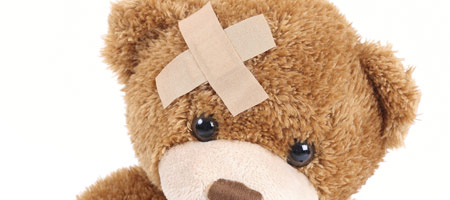First Aid Tips
Children are very active and energetic and unfortunately this can lead to an array of potential injuries from bee stings to cuts and scrapes.
It is an inevitable fact: children get hurt. Children by nature are very active and energetic. This leads to an array of potential injuries ranging the gamut from bee stings, to cuts and scrapes, and just about everything in between.
One of the best things you can do is to be prepared for anything by having a complete first aid kit. Since it is not likely that you will find a pre-made kit that has everything you will need in it, it is best to make your own from scratch so that you always have everything you need. You will also want to keep your kit up high or in a locking cabinet out of the reach of children.
Perhaps the most important thing you can put in your first aid kit is phone numbers and names. This should be sewn, glued, or taped on the inside of your kit and should include information for your doctor, the local hospital, and a nearby neighbour or family member, as you may need someone to stay with another child if one needs to be taken for care, or you may need a ride to the hospital.
Now, let’s talk about what should be kept in a good first aid kit.
- A good quality thermometer, preferably a digital quick read thermometer that can be used in just a few seconds.
- Liquid pain reliever that contains either ibuprofen or paracetamol. You will want to make sure you have a proper dosing spoon or syringe, as well as instructions.
- Some type of antiseptic ointment or lotion for cleaning scrapes and cuts. This is also a good thing to have on hand to apply to cuts, scrapes, and minor burns in order to prevent infection.
- Saline solution or eye wash to clean dirt and other particulate material out of the eyes.
- Tweezers to remove thorns, splinters, stingers, or other items in the skin.
- Insect repellent.
- Sterile gauze.
- Disposable gloves.
- An assortment of bandages.
- Adhesive tape.
- Ice pacts that can be activated by squeezing so they are always ready to use and do not require the need to be kept in the freezer.
- Calamine lotion for rashes and insect bites.
- Antihistamine cream for rashes and insect bites.
- Antiseptic wipes which are quite handy to use for various types of cuts, burns, scrapes, and bites. These quickly clean wounds and remove germs and dirt.
- Sticky plaster that can be made into many different shapes and sizes.
- Sharp scissor for cutting bandages, gauze, and plaster.
If you have a child with an allergy, such as to shellfish, bees, peanuts, or other substance, you will want to make sure to always carry medication with you. The same holds true for those with asthma. Check to make sure all medication is up to date, and not expired.
It certainly cannot hurt to have more than one first aid kit. You may want a big one for the house, but several smaller kits for the car or the nappy bag. No matter where you decide to keep first aid kits, just make sure they are properly secured so that all items are kept safely out of the hands of children.

